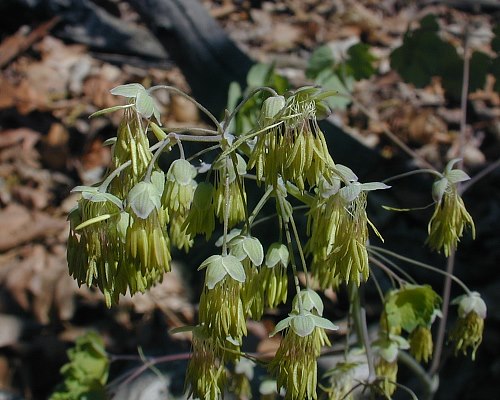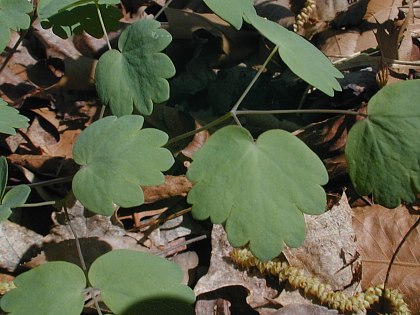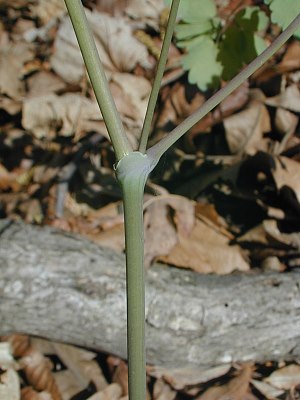Description: This perennial wildflower is up to 2½' tall and across. Its central stem (and any side stems) is pale green to pale purplish green, terete, glabrous, and glaucous. The alternate compound leaves are double or triple odd-pinnate, spanning up to 1' long and across. Each branch of a compound leaf has 3 or 5 leaflets; like the central stem, the branches of the compound leaves are pale green to pale purplish green, glabrous, and glaucous. Individual leaflets are up to 1¾" long and across; they are reniform-orbicular to oval-orbicular in shape with 3-9 terminal lobes (usually 5 or more). These short lobes are well-rounded or bluntly pointed. The upper surface of each leaf is medium green and smooth, while the lower surface is pale green with a conspicuous network of raised veins; both sides are hairless. All of the leaflets have slender petioles.

The central stem terminates in a large floral panicle up to 1' tall and across; each branch of the panicle terminates in a corymb of about 5 flowers. Because Early Meadow Rue is dioecious, some plants produce all male (staminate) flowers, while other plants produce all female (pistillate) flowers. The male flowers droop downward from their branches to a greater extent than the female flowers. Each male flower is about ¼" across and ½" long; it consists of 4-5 sepals and 10 or more stamens. The sepals are broadly oblong, pale green, light-veined, and white-margined; the stamens have long yellow anthers and slender filaments. Each female flower is about the same size as the male flower; it consists of 4-5 sepals and up to 15 pistils. The sepals are similar to those of the male flowers, while the pistils are grey with flat-sided styles. Neither male nor female flowers have petals. The blooming period occurs from mid- to late spring. Cross-pollination is by wind and there is no floral fragrance. The male flowers soon wither away, while the fertile female flowers are replaced by ellipsoid achenes that are pointed at both ends and strongly ribbed. After flowering plants die down during the summer, low basal leaves develop during the fall. Their appearance is similar to the alternate compound leaves, as described above. The root system is fibrous and rhizomatous. This wildflower can reproduce by its rhizomes or achenes.

Cultivation:
The
preference is light shade, mesic conditions, and a loam or clay-loam
soil. Most vegetative growth occurs during the spring and early summer.
Range & Habitat:
The native Early Meadow Rue is occasional in eastern central and
northern
Illinois, but it is uncommon or absent elsewhere in the state (see Distribution
Map). Habitats include rich mesic woodlands, wooded clay
slopes, shaded areas near cliffs, and rocky ravines. In Illinois, this
species is typically found in Maple-Basswood woodlands. It blooms
before the canopy trees have fully developed their leaves.
Faunal Associations:
The caterpillars of the following Noctuid moths feed on Thalictrum
spp. (Meadow Rue species) – Calyptra canadensis
(Canadian Owlet), Papaipema unimoda (Borer Moth
sp.), and Pseudeva purpurigera (Straight-Lined
Looper Moth). White-Tailed Deer browse on the foliage of Early Meadow
Rue sparingly.

Photographic
Location:
A mesic woodland in east-central Illinois. The photographed plant is
staminate (male).
Comments:
Early Meadow Rue is shorter in stature and blooms earlier than other
Thalictrum spp. in Illinois. It also has greater fidelity to
shady woodlands as a habitat. All of these species have elegant foliage
and unusual wind-pollinated flowers. The male flowers of Early Meadow
Rue are more showy than the female flowers; this is primarily because
the anthers of the male flowers are yellow, while the styles of the
female flowers are dull-colored. The leaflets of Early Meadow Rue have
more terminal lobes (usually 5-9) than the leaflets of other Thalictrum
spp. in the state (usually 3-5). Because of this distinctive
characteristic, it is easy to identify.